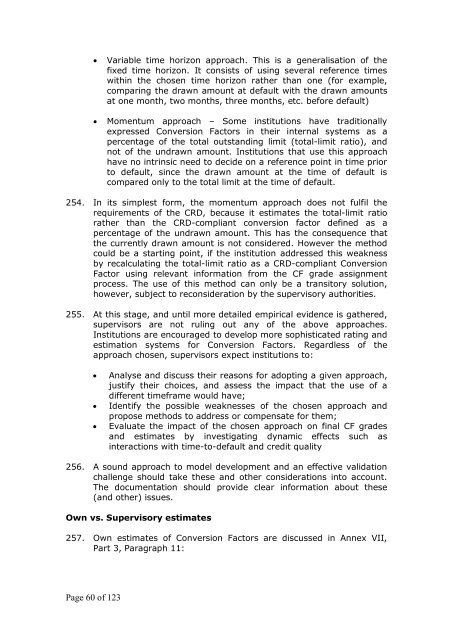CP10 (Full Document) - European Banking Authority
CP10 (Full Document) - European Banking Authority
CP10 (Full Document) - European Banking Authority
You also want an ePaper? Increase the reach of your titles
YUMPU automatically turns print PDFs into web optimized ePapers that Google loves.
· Variable time horizon approach. This is a generalisation of the<br />
fixed time horizon. It consists of using several reference times<br />
within the chosen time horizon rather than one (for example,<br />
comparing the drawn amount at default with the drawn amounts<br />
at one month, two months, three months, etc. before default)<br />
· Momentum approach – Some institutions have traditionally<br />
expressed Conversion Factors in their internal systems as a<br />
percentage of the total outstanding limit (totallimit ratio), and<br />
not of the undrawn amount. Institutions that use this approach<br />
have no intrinsic need to decide on a reference point in time prior<br />
to default, since the drawn amount at the time of default is<br />
compared only to the total limit at the time of default.<br />
254. In its simplest form, the momentum approach does not fulfil the<br />
requirements of the CRD, because it estimates the totallimit ratio<br />
rather than the CRDcompliant conversion factor defined as a<br />
percentage of the undrawn amount. This has the consequence that<br />
the currently drawn amount is not considered. However the method<br />
could be a starting point, if the institution addressed this weakness<br />
by recalculating the totallimit ratio as a CRDcompliant Conversion<br />
Factor using relevant information from the CF grade assignment<br />
process. The use of this method can only be a transitory solution,<br />
however, subject to reconsideration by the supervisory authorities.<br />
255. At this stage, and until more detailed empirical evidence is gathered,<br />
supervisors are not ruling out any of the above approaches.<br />
Institutions are encouraged to develop more sophisticated rating and<br />
estimation systems for Conversion Factors. Regardless of the<br />
approach chosen, supervisors expect institutions to:<br />
· Analyse and discuss their reasons for adopting a given approach,<br />
justify their choices, and assess the impact that the use of a<br />
different timeframe would have;<br />
· Identify the possible weaknesses of the chosen approach and<br />
propose methods to address or compensate for them;<br />
· Evaluate the impact of the chosen approach on final CF grades<br />
and estimates by investigating dynamic effects such as<br />
interactions with timetodefault and credit quality<br />
256. A sound approach to model development and an effective validation<br />
challenge should take these and other considerations into account.<br />
The documentation should provide clear information about these<br />
(and other) issues.<br />
Own vs. Supervisory estimates<br />
257. Own estimates of Conversion Factors are discussed in Annex VII,<br />
Part 3, Paragraph 11:<br />
Page 60 of 123

















